- Automotive
- Battery Lamination
- Ball Grid Array (BGA)
- Bed / Mattress
- Biomechanics
- Brake Pad
- Body Mapping
- Bolted Joint
- Bolt Switch
- Bolt Pressure Indicator
- Calender Press
- Clamping
- Composite Layup
- Connector
- Clutch
- Door Seal
- Ergonomics
- Flex
- Foot
- Foot Insole
- Fuel Cell Manufacturing
- Gasket Sealing
- Glove
- Hand Grip Pressure
- Heat Sealing
- Heat Sink
- Human Body Interface
- Impact Study
- Injection Molding
- LCD Bonding
- Metal Stamping
- Lamination Press
- Nip Impression
- Patient Movement Monitor
- Podiatry / Orthotics
- Printed Circuit Board
- Saddle Fitting
- Seating
- Soil-Structure Interaction
- Solar Cells
- Spray
- Squeezable Tube
- Tire Tread Footprint
- Temperature Mapping
- Ultrasonic Welding
- UV Light Measurement
- Vest / Body Armor
- Wafer Bonding
- Wafer Polishing
- Windshield Wiper
- Squeegee
- Other Applications

- Automotive
- Battery Lamination
- Ball Grid Array (BGA)
- Bed / Mattress
- Biomechanics
- Brake Pad
- Body Mapping
- Bolted Joint
- Bolt Switch
- Bolt Pressure Indicator
- Calender Press
- Clamping
- Composite Layup
- Connector
- Clutch
- Door Seal
- Ergonomics
- Flex
- Foot
- Foot Insole
- Fuel Cell Manufacturing
- Gasket Sealing
- Glove
- Hand Grip Pressure
- Heat Sealing
- Heat Sink
- Human Body Interface
- Impact Study
- Injection Molding
- LCD Bonding
- Metal Stamping
- Lamination Press
- Nip Impression
- Patient Movement Monitor
- Podiatry / Orthotics
- Printed Circuit Board
- Saddle Fitting
- Seating
- Soil-Structure Interaction
- Solar Cells
- Spray
- Squeezable Tube
- Tire Tread Footprint
- Temperature Mapping
- Ultrasonic Welding
- UV Light Measurement
- Vest / Body Armor
- Wafer Bonding
- Wafer Polishing
- Windshield Wiper
- Squeegee
- Other Applications
- Fujifilm Prescale
- Fujifilm Thermoscale
- Tactilus
- Nip Roller Products
- Topaq
- Mold-Align
- Pressurex-micro
- TemprX
- Thermex
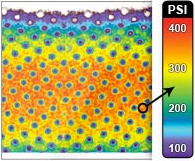
Fujifilm Prescale®
Fujifilm Prescale is a unique, affordable and easy to use tool that reveals the distribution and magnitude of pressure between any two contacting, mating or impacting surfaces. This Tactile Pressure Indicating Sensor Film is extremely thin (4 to 8 mils) which enables it to conform to curved surfaces. Fuji Prescale Film is ideal for invasive intolerant environments and tight spaces not accessible to conventional electronic transducers.
Click here to read more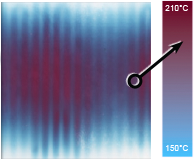
Fujifilm Thermoscale®
Thermoscale® is a unique tool that indicates temperature level and distribution between any two contacting surfaces. The most unique quality of Thermoscale® is that is goes where no other IR camera or temperature gauge can ever go - on the surface of the heated object and in between two contacting surfaces!
Click here to read moreTactilus®
A matrix-based tactile surface sensor that interprets pressure distribution & magnitude... read more
Bodyfitter®
Most economical technique to capture mattress "fit" data... read more
Tactilus® Flex
Ideal for applications/devices that require measurement of repetitive bending motion... read more
Tactilus® Free Form sensor system
A "user constructed" tactile surface pressure system that provides unprecedented flexibility... read more
Tactilus® Free Form Development Kit
The Free Form® Development Kit is highly economical yet powerful... read more
Tactilus® Nano-Polymer Core | H-series Sensor
A nano-polymer based tactile surface sensor. With more accuracy, less drift & better repeatability... read more
Tactilus® Nano-Polymer Core | C-series Sensor
A nano-polymer based tactile surface sensor. With more accuracy, less drift & better repeatability... read more
Tactilus® Ultra High Density Spatial Resolution
A nano-polymer based tactile surface sensor. With more accuracy, less drift & better repeatability... read more
Tactilus® For Ultra Sensitive Force Measurement
A nano-polymer based tactile surface sensor. With more accuracy, less drift & better repeatability... read more
Tactilus® Stretch Sensor
A true stretch sensor where the entire sensor element stretches to conform to your surface... read more
Tactilus® Bicycle Seat Sensor System
The Tactilus® Bicycle Seat Sensor System evaluates the pressure on the bicycle seat during the pedal cycle... read more
Tactilus® Nip Impression | H-Series
The Tactilus® nip measurement tool captures nip pressure and parallelism information from between any two mating rolls... read more
Tactilus® R-Series Sensor
Tactilus® allows the user to capture and record pressure conditions occurring between any two contacting or impacting surfaces in real time.... read more
Auto-Nis®
is a Windows base scanner and software system that enables... read more
DigiNip®
is a powerful new system that allows the quick and easy diagnosis... read more
EZ-Nip®
is an extremely economical and practical solution for determining... read more
Sigma-Nip®
is an electronic nip analysis system that calculates and records nip width... read more
Shoe Press Profiler®
The Shoe Press Profiler® easily allows any technician to quickly and easily capture an... read more
Fujifilm Prescale®
Fujifilm Prescale is a unique, affordable and easy to use tool that reveals the distribution... read more

Topaq® Pressure Analysis System
Used in conjunction with Fujifilm Prescale pressure indicating films, Topaq provides a quick, yet thorough analysis of the pressure distribution and magnitude between any two surfaces that come into contact... read more
Topaq® Service
Need to obtain statistical data and enhanced digital visuals of your Fujifilm Prescale? Let our technicians analyze your pressure exposed impressions with the all new Topaq Pressure Analysis System... read more

Mold Align®
Mold-Align is a unique, affordable and easy to use tool that reveals pressure distribution between mold platens. Mold-Align paper, which changes color relative to the amount of contact force. It is an extremely economical and practical solution for determining proper mold alignment... read more
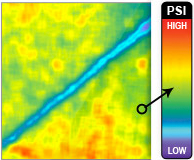
Pressurex-micro®
Pressurex-mirco is a unique, affordable and easy to use tool that reveals relative pressure distribution between two contacting, mating or impacting surfaces. This pressure indicating sensor film is thin (20 mils) which enables it to conform to curved surfaces. It is ideal for invasive intolerant environments and tight spaces not accessible to conventional electronic transducers... read more
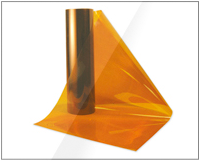
TemprX®
Fuji Prescale film is a unique, affordable and easy to use tool that reveals the distribution and magnitude of pressure between any two contacting, mating or impacting surfaces. With the use of TemprX thermal protection polyimide film it can be used in applications that reach high temperatures... read more
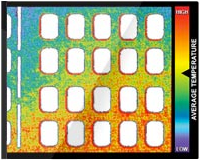
Thermex®
Thermex® is a unique temperature indicating material. As thin as a standard sheet of paper, Thermex changes color to reveal relative temperature distribution between any two contacting surfaces. Upon exposure to temperature, the Thermex® sheet instantaneously and permanently changes color, with the intensity of that color directly related to the temperature it was exposed to. This allows Thermex to reveal spot high or low temperature zones. Thermex® is inexpensive, precise and disposable... read more
- Topaq Service
- Encasement
- In-House Consulting
- Laser Cutting
- Leasing
- R&D Engineering
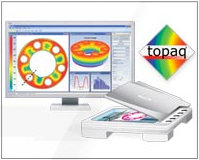
Topaq® Service
Need to obtain statistical data and enhanced digital visuals of your Fuji Prescale films? Let our technicians analyze your pressure exposed impressions with the all new Topaq Pressure Analysis System.
Click here to read more
Encasement Service
Our new Encasement Service for Pressure Indicating Film offers engineers in the flexo, converting and packaging industries the ability to have Fujifilm Prescale protected so that it can measure contact pressure.
Click here to read more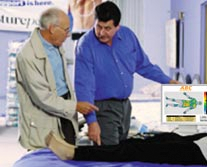
In-House Consulting
Sensor Products now introduces our new in-house surface stress analysis service. All you need to do is send your part, machine, fixture or assembly to us and we’ll do the rest. Via video-conferencing you can view the results of our analysis practically in real-time.
Click here to read more
Laser Cutting
We offer custom laser cutting services for tactile pressure sensor film to measure contact pressure.
Click here to read more

Leasing Options
Sensor Products offers a variety of products that are available for short and long term lease. A lease will enable you to gain access to the benefits of our products without the commitment to buy. Furthermore, after your analysis you can also send the session data back to us for a more in-depth review and critique.
Click here to read more
R&D Engineering
Sensor Products has a highly dedicated team of talented engineers with 25 years of combined experience in the niche discipline of tactile surface sensing. Your project will be supervised by a product manager who will be your direct contact, and worked upon by our staff consists of material, mechanical, and PHD level electrical engineers.
Click here to read more





